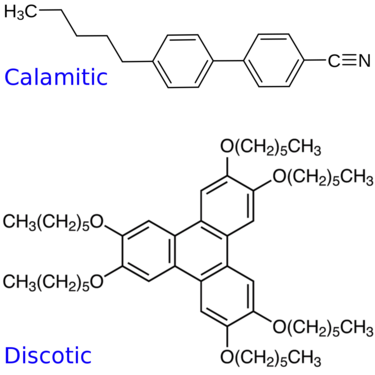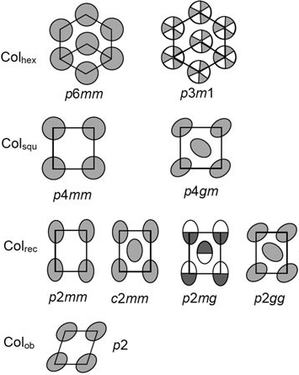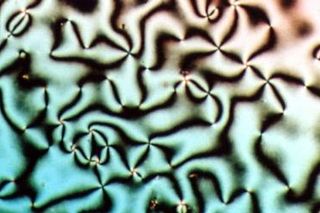
Liquid crystal (LC) is a state of matter whose properties are between those of conventional liquids and those of solid crystals. For example, a liquid crystal can flow like a liquid, but its molecules may be oriented in a common direction as in solid. There are many types of LC phases, which can be distinguished by their optical properties. The contrasting textures arise due to molecules within one area of material ("domain") being oriented in the same direction but different areas having different orientations. An LC material may not always be in an LC state of matter.
The columnar phase is a class of mesophases in which molecules assemble into cylindrical structures to act as mesogens. Originally, these kinds of liquid crystals were called discotic liquid crystals or bowlic liquid crystals because the columnar structures are composed of flat-shaped discotic or bowl-shaped molecules stacked one-dimensionally. Since recent findings provide a number of columnar liquid crystals consisting of non-discoid mesogens, it is more common now to classify this state of matter and compounds with these properties as columnar liquid crystals.
A biaxial nematic is a spatially homogeneous liquid crystal with three distinct optical axes. This is to be contrasted to a simple nematic, which has a single preferred axis, around which the system is rotationally symmetric. The symmetry group of a biaxial nematic is i.e. that of a rectangular right parallelepiped, having 3 orthogonal axes and three orthogonal mirror planes. In a frame co-aligned with optical axes the second rank order parameter tensor of a biaxial nematic has the form
In liquid crystals, homeotropic alignment is one of the ways of alignment of liquid crystalline molecules. Homeotropic alignment is the state in which a rod-like liquid crystalline molecule aligns perpendicularly to the substrate. In the polydomain state, the parts also are called homeotropic domains. In contrast, the state in which the molecule aligns to a substance in parallel is called homogeneous alignment.
A liquid crystal phase is thermotropic if its order parameter is determined by temperature. At high temperatures, liquid crystals become an isotropic liquid and at low temperatures, they tend to glassify. In a thermotropic crystal, those phase transitions occur only at temperature extremes; the phase is insensitive to concentration.
Liquid crystal polymers (LCPs) are polymers with the property of liquid crystal, usually containing aromatic rings as mesogens. Despite uncrosslinked LCPs, polymeric materials like liquid crystal elastomers (LCEs) and liquid crystal networks (LCNs) can exhibit liquid crystallinity as well. They are both crosslinked LCPs but have different cross link density. They are widely used in the digital display market. In addition, LCPs have unique properties like thermal actuation, anisotropic swelling, and soft elasticity. Therefore, they can be good actuators and sensors. One of the most famous and classical applications for LCPs is Kevlar, a strong but light fiber with wide applications, notably bulletproof vests.
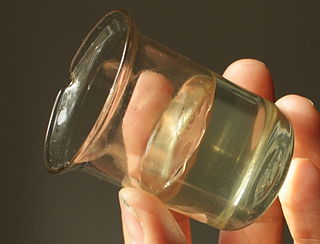
Lyotropic liquid crystals result when fat-loving and water-loving chemical compounds known as amphiphiles dissolve into a solution that behaves both like a liquid and a solid crystal. This liquid crystalline mesophase includes everyday mixtures like soap and water.
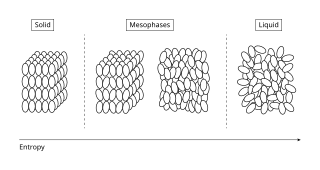
In chemistry and chemical physics, a mesophase or mesomorphic phase is a phase of matter intermediate between solid and liquid. Gelatin is a common example of a partially ordered structure in a mesophase. Further, biological structures such as the lipid bilayers of cell membranes are examples of mesophases. Mesophases with long-range positional order but no orientational order are plastic crystals, whereas those with long-range orientational order but only partial or no positional order are liquid crystals.
A blue phase mode LCD is a liquid crystal display (LCD) technology that uses highly twisted cholesteric phases in a blue phase. It was first proposed in 2007 to obtain a better display of moving images with, for example, frame rates of 100–120 Hz to improve the temporal response of LCDs. This operational mode for LCDs also does not require anisotropic alignment layers and thus theoretically simplifies the LCD manufacturing process.

Alfred Saupe was a German Physicist born in Badenweiler, who laid groundbreaking work in the area of liquid crystal studies.

Sivaramakrishna Chandrasekhar FNA, FRS was an Indian physicist who won the Royal Medal in 1994. He was the founder-president of the International Liquid Crystal Society.
Discotic liquid crystals are mesophases formed from disc-shaped molecules known as "discotic mesogens". These phases are often also referred to as columnar phases. Discotic mesogens are typically composed of an aromatic core surrounded by flexible alkyl chains. The aromatic cores allow charge transfer in the stacking direction through the π conjugate systems. The charge transfer allows the discotic liquid crystals to be electrically semiconductive along the stacking direction. Applications have been focusing on using these systems in photovoltaic devices, organic light emitting diodes (OLED), and molecular wires. Discotics have also been suggested for use in compensation films, for LCD displays.

4-Cyano-4'-pentylbiphenyl is a commonly used nematic liquid crystal with the chemical formula C18H19N. It frequently goes by the common name 5CB. 5CB was first synthesized by George William Gray, Ken Harrison, and J.A. Nash at the University of Hull in 1972 and at the time it was the first member of the cyanobiphenyls. The liquid crystal was discovered after Gray's group received a grant from the UK Ministry of Defence to find a liquid crystal that had liquid crystal phases near room temperature with the specific intention of using them in liquid crystal displays. The molecule is about 20 Å long. The liquid crystal 5CB undergoes a phase transition from a crystalline state to a nematic state at 22.5 °C and it goes from a nematic to an isotropic state at 35.0 °C.
Ammonium perfluorononanoate (APFN) is an anionic surfactant that in water forms liquid crystalline phases. It is the ammonium salt of perfluorononanoic acid.

Temperature sensitive glass is a glass material that reacts to ambient temperatures radiated off of other surfaces, e.g. hands or water. The liquid crystals beneath the glass surface impact color upon temperature. There are three main phases of these crystals: nematic, smectic, and chiral.

Antal I. "Tony" Jákli is a Hungarian-American physicist and professor of chemical physics at Kent State University. He is known for his work with bent-core, flexoelectric, and ferroelectric liquid crystals.
Liquid crystal elastomers (LCEs) are slightly crosslinked liquid crystalline polymer networks. These materials combine the entropy elasticity of an elastomer with the self-organization of the liquid crystalline phase. In liquid crystalline elastomers, the mesogens can either be part of the polymer chain or are attached via an alkyl spacer.

Nelamangala Vedavyasachar Madhusudana is an Indian physicist and an emeritus scientist at Raman Research Institute. Known for his research on liquid crystals, Madhusudhana is an elected fellow of Indian Academy of Sciences and Indian National Science Academy. The Council of Scientific and Industrial Research, the apex agency of the Government of India for scientific research, awarded him the Shanti Swarup Bhatnagar Prize for Science and Technology, one of the highest Indian science awards, for his contributions to physical sciences in 1989.
Noel Anthony Clark is an American physicist, university professor at the University of Colorado Boulder, and pioneer in the development of electro-optical applications of liquid crystals.
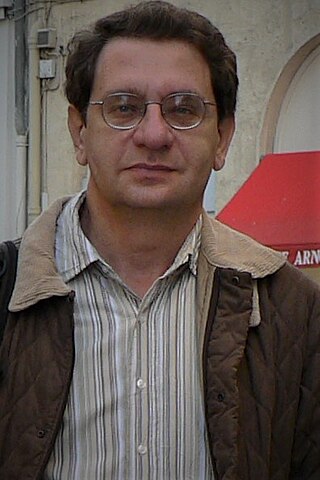
Yuriy Reznikov was a Ukrainian physicist, Head of the Department of Crystals at NASU Institute of Physics and a world-renown expert in the field of liquid crystals. He is known for his work on photoalignment, "giant" optical non-linearity of liquid crystals and nano-colloids.

